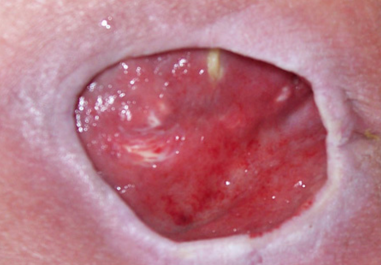Braden Score Calculator

The Braden Score calculator is a calculator that calculates a person's risk for developing pressure ulcers.
Pressure ulcers are sores that develop anywhere on the body which sustains pressure for a long time. Thus, pressure ulcers are also called pressure sores.
There are various stages of pressure ulcers depending on how deep it goes into a person's skin. But all pressure ulcers are the result of skin breakdown and penetrates at least with some depth into the skin.
The Braden score depends on 6 different factors. These factors are a person's sensory perception, moisture, activity, mobility, nutrition, and friction and shear.
Based on these factors, it can be estimated whether a person is at high or low risk for developing pressure ulcers.
Scores range from 6-23. The higher the score, the less risk a person has of developing pressure ulcers. The lower the score, the greater risk a person has of developing pressure ulcers.
Sensory perception measures a person's senses, such as he or she is able to see, hear, touch, taste, and smell what's around him. Sensory perception is scored from completely limited (1), very limited (2), slightly limited (3), and no sensory impairment at all (4).
Moisture measures how moist an individual normally is. Moisture represents a negative thing, since people who are moist are more likely to have skin breakdown. This can be moist from any fluid, but particularly urine, since urine is very acidic and more easily causes skin breakdown. Moisture is scored from constantly moist (1), often moist (2), occasionally moist (3), and rarely moist (4).
Activity measures how much activity an individual engages in throughout the course of a day. Greater activity leads to a less risk of pressure ulcers, since the person is staying bound to one place. Being bedfast is the worst, since a person is confined to one position. This can place pressure on a certain area for an extended period, increasing the likelihood of ulceration. Moving around is best, since no part of the body receives continual pressure. Activity is scored from bedfast (1), chairfast (2), walks occasionally (3), and walks frequently (4).
Mobility measures how limited a person is to moving about. Mobility is scored from completely immobile (1), very limited (2), slightly limited (3), and no limitations (4).
Nutrition measures how adequate and nutritious a person's diet is. Nutrition plays a role with pressure ulcers becasue good nutrition helps to keep the skin healthy. Without good nutrition, including stay hydrated, a person's skin will be less resilient and be more prone to breakdown. Thus, nutrition is an important to maintaining skin integrity. Nutrition is scored from very poor (1), probably adequate (2), adequate (3), and excellent (4).
Friction and shear measures how much a person's body is rubbing against another object, which normally is the bed or chair a person is confined to. If a person is bedboud and his skin is constantly shearing against the bedsheet up and down, over and over, this can cause skin breakdown and pressure ulcers. The greater the friction, the more chance of pressure ulcers. The less the friction and shearing, the less chance a person has of developing pressure ulcers. Friction and shear is scored from problem (1), potential problem (2), and no apparent problem (3). It is the only category that is scored from 1-3; all the others are scored from 1 to 4.
Since there are 6 categories of the Braden score and each has a minimum of a score of 1, the minimum score is 6. Since each category except friction and shear has a score of 4 (friction and shear has a score of 3, the maximum score is 23.
The Braden score is a good predictor of whether a person will develop pressure
ulcers. It's just an estimator, as many of the categories can't be determined definitely, but generally.
But all the factors that comprise it have a direct correlation to pressure ulcer formation.
Related Resources
Glasgow Coma Scale Calculator
Cardiac Output Calculator
Stroke Volume Calculator
Pulse Pressure Calculator
Mean Arterial Pressure Calculator
Naegele's Rule Calculator
Bartholomew's Rule of Fourths Calculator
Parkland Formula Calculator
IV (Macro) Drip Rate Calculator
IV Micro Drip Rate Calculator
IV Flow Rate Calculator
Alcohol Metabolism Calculator